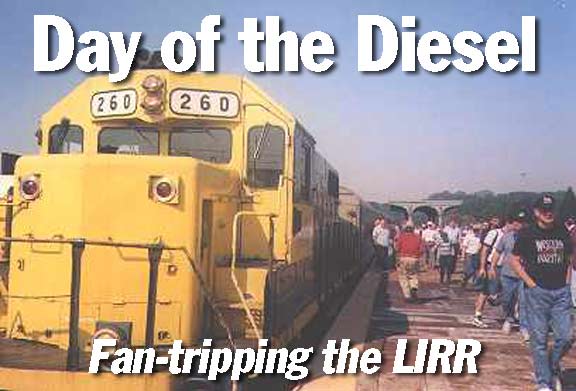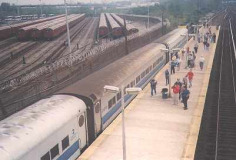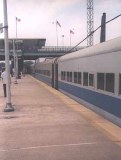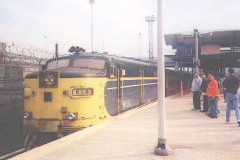In the past few months (as of this writing, April 2000) the Long Island Rail Road (or, as some call it, the Long Island Fail Road) has completely replaced its fleet of ancient cars going back to the mid-1950s with a modern, bright fleet of bi-level cars. While many railfans (including me) welcome the new cars, I always got the feel of old railroading when riding the old diesels. They had a patina of grime and dirt that had encrusted on them through the decades, the windows were permanently fogged up (though you could usually find one or two clean windows to look out of per car). On those hot days, you could ride between cars to catch a breeze. And, the walls had garish red carpeting.What else could you possibly want from a railroading experience? The new cars are hybrids and are at home both with third rail and are self-powered on eastern Long Island where tracks aren’t electrified.
On September 25th, 1999, the Electric Railroaders’ Association, a popular railfans’ organization, sponsored a fantrip in which a run of diesel cars would be given one last grand tour of the Long Island Rail Road. Beginning in Jamaica, the train first went west to Hunters Point, east to Port Washington, west again to Woodside, east to Babylon, west to Jamaica, east again to West Hempstead, west again to Valley Stream, south to Island Park, then back to Jamaica. There were frequent stops for folks to take the final video and snapshots of the venerable cars in service.
Of special interest to me were the runs on the Port Washington and Long Beach LIRR branches, which were electrified long ago and have rarely, if ever, seen any diesel passenger service.
Railfanners congregate on the Shea Stadium platform, which only sees use from April to October during Mets home games and US Open tennis matches. The layup yard for the IRT Flushing Line (#7) is in the background. Rarely, if ever, have Engines #260 and #614 and Shea Stadium been seen in the same photograph!
[Both the MP50 LIRR cars and the R33-36 IRT cars have been retired]
Auburndale, a short-platformed station on the Port Washington branch on 192nd Street, has been completely renovated in 2002, with a new station house, elevator and a platform extended to standard length. It received a rare visit from the MP50s in September 1999.
The Richmond Hill station, on Lefferts Boulevard and Jamaica Avenue, is notable for a couple of reasons:
— It’s one of the few abandoned LIRR stations that has been allowed to remain intact
— It’s the only elevated abandoned LIRR station
— It’s one of the few occasions when an active LIRR line passes under or over an elevated train.
The 260 pauses to allow railfans a breather on a hot September day.
The Richmond Hill station dates to the 1920s, when this section of the railroad was elevated and grade crossings were eliminated. (There are a few grade crossings further west on the line). This shed covered the stairway to the street.
A scene that will rarely, if ever, be played out on this line again. Note the car ad; cars aided the demise of this branch, and service and ridership dwindled, spiraling down together until the station’s lines were closed for good in 1998.
In a rare meeting of the BMT and LIRR, BMT J tracks pass over the LIRR.
There are only four occasions where a direct connection from the subway and LIRR is possible:
Penn Station (1,2,3, A,C, E)
Woodside (7)
Sutphin Blvd (E, J, Z)
Flatbush Avenue (2, 3, 4, 5, B, D, N, Q, R, though only the IRT is next to the tracks.)
There are close calls, like East New York and Atlantic Avenue (L) and at Flushing Main Street (7), but the connections require some walking.
This view of the concrete Richmond Hill trestle from Hillside Avenue lets us see one of the LIRR’s most intriguing relics: the Keystone.
The LIRR was run under the auspices of the Pennsylvania Railroad from 1928 to 1966, and in those years, the LIRR signage adopted the “Pennsy” keystone symbol, since Pennsylvania, as everyone knows, is the Keystone State. The LIRR’s chuffing steam engines all carried a keystone plate on their noses.
This is the layup outside the Oyster Bay station showing the old and new LIRR trainsets.
By late 1999, all the old cars had been retired. The bilevels, which can operated with and without third rail, can come into Penn Station, a place the old cars never could venture.
4/6/2000; revised 2012















5 comments
Am I correct to assume that Richmond Hill station received Diesel Service and not electric
service to and from Penn Station?
No. The terminal was Long Island City.
I use to live in Flushing,Queens N.Y. This was 52 years ago, I have ridden the Long Island Railroad when they had the old tuscan red mu and double deck coaches on the Port Washington line that ran through Flushing back in the 1950s.I moved to Phoenix,Arizona in August 1961.Ive only been back twice, in 1968 and 1974. A lot has changed since then.I still reside in Phoenix,going on 53 years this coming August 2014.
Remember when LIRR rolled out the sleek looking M1 Budd cars back in late 60’s. They were state of the art, and turned lot of heads. Not big fan of the M7 cars now in service. To boxy looking, and unattractive !! What did LIRR do with the over 700 retired M1 cars anyway ???
Ozone Park is another abandoned elevated station that was part of the Rockaway line. It was shut down when NYC subway operations cut in it’s line (south of it) in 1955.